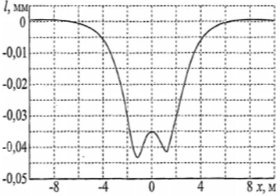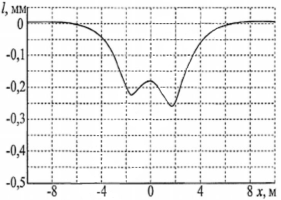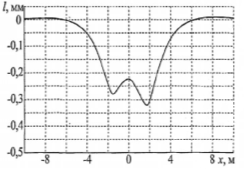The article analyzes the causes of rutting and cracks that occur in asphalt concrete roads.
Keywords: asphalt concrete pavement, irreversible deformation, road surface, materials, construction, gauge deformation, cracks.
The problem of formation and elimination of rut deformations and cracks in asphalt concrete pavements has been considered one of the most important issues for road engineers in many countries of the world for a long time. Data analysis shows that wheel track deformation and the formation of cracks account for 20 %-35 % of all reasons for the decrease in traffic performance of highways [1]. The deformations and cracks of the wheel tracks on the highways occur for 3–5 years after the highways are put into operation, and as a result of the high-speed and long-term movement of cars on the roads, road traffic accidents are more often observed on the roads with the deformations of the wheel tracks of 15–17 mm [1,2].
To date, many researches abroad as N. N. Ivanov, A. K. Birulya, A. M. Boguslavskyi, B. I. Ladygin, N.Ya. Kharkhuta, A. P. Vasiliev, I. A. Zolotar, V. D. Kazarnovsky, M. S. Koganzon, A. V. Rudensky, A. V. Smirnov, Yu.M. Yakovlev, A. N. Alexandrov, M. G. Goryachev, A. N. Elgonov, B. V. Justareva, S. Yu. Kanygin, G. N. Kiryukhin, Z. A. Mevlidinov, A. A. Negomedzyanov, V. M. Smirnov, A. V. Edelman, Vatanata, Veverki, Gshwendt, Finn, Husheka, in Uzbekistan as N. Makhmudov, A. F. Sulaymanov and others [1,2,3,4] have been conducted to study the causes of deformations and cracks in highways. They studied the process of formation of residual deformations on roads with asphalt-concrete pavement as a result of the effect of high air temperature and traffic volume with different components.
The road surface receives various static and dynamic effects from the wheel load of motor vehicles. The horizontal displacements that occur during braking and acceleration in the upper layer of the road surface lead to the appearance of waves that participate in the formation of irreversible deformations associated with the magnitude of the traffic impact. Vertical deformations of asphalt concrete pavements lead to stresses that penetrate deep into the road structure. The greater the specific pressure from the wheels of vehicles on the road surface and the smaller the area of its footprint, the higher the probability of formation of wheel footprint deformation in the pavement.

Fig. 1. Wheel track deformation in asphalt concrete pavement.
Wheel track deformations and the formation of cracks in asphalt concrete pavements also depend on the type of asphalt concrete pavement laid, and are different for different types of pavements.
Б type (mixed 1) — 18,3 mm
Б type (mixed 2) — 8,3 mm
А type-6.7 mm
Crushed limestone-mastic asphalt concrete — 2.7 mm.
In the case where the wheel track deformations on asphalt concrete pavements exceed the values given in Table 1, the traffic safety of vehicles is affected, and repair work is determined according to [10].
Table 1
|
Road category |
Types of coating |
Wheel track depth, cm |
Wheel track length, m |
Wheel track repair period (from the specified time) days |
|
I, I a , I b |
А, Б |
More than 2- cm |
Longer than 7- m |
5 |
|
II |
Б |
More than 2,5- cm |
Longer than 7- m |
7 |
|
III |
В, Г |
More than 3- cm |
Longer than 9- m |
10 |
|
IV |
Д |
More than 3- cm |
Longer than 9- m |
14 |
Asphalt concrete pavement receives various static and dynamic loads from vehicle wheels during movement of heavy vehicles, horizontal stresses occurring on the pavement surface of heavy vehicles during braking and acceleration, formation of residual deformations in the pavement as a result of the influence of high summer air temperatures, and the long-term effects of these processes causes wheel track deformations to appear under it.
Data analysis shows that, like many other deformations, the formation of wheel track deformation and cracks are caused by two negative factors:
external factors — impact of load, climatic factors, air temperature and sunlight, moisture of soil layer;
internal factors — physical and mechanical properties of the structure, resistance to displacement, condition of the coating structure, strength and level of density.
As a result of the continuous movement of heavy sports vehicles on asphalt concrete pavements in one track during high air temperature, it has a direct effect on the appearance of wheel track deformation in the pavement, and the depth of the resulting wheel tracks is found by the following formula [4]:


here:
N- the number of heavy goods vehicle passes. car/day
Т– asphalt concrete pavement temperature С°.
b– the coefficient of increase of load.
a and Q– correlation coefficient of the size of wheel tracks on asphalt concrete pavement.
Although several other researchers who conducted scientific work in this field [5] emphasized that the movement of light vehicles does not have a significant effect on the deformations of wheel tracks and the formation of cracks in the asphalt concrete pavement, it is necessary to take into account the effect of the erosion of the coating during the movement of light vehicles on the road surface, because on highways light vehicles make up to 80 % of the total number of cars in motion. For this reason, several researchers have studied the effect of light, heavy and different types of trucks on the formation of wheel track deformations in asphalt concrete pavements (figures 2, 3 and 4) [9].
|
Bending of the pavement under the influence of vehicles |
|
Bending of the pavement under the influence of vehicles |
|
|
Left and right side of the wheel axle |
Left and right side of the wheel axle |
||
|
Fig. 2. Cross-sectional diagram of wheel tracks on pavement resulting from the impact of light vehicles |
Fig. 3. Cross-sectional diagram of wheel tracks on pavement caused by heavy vehicles |
||
|
Bending of the pavement under the influence of vehicles |
|
Bending of the pavement under the influence of vehicles |
|
|
Left and right side of the wheel axle |
Left and right side of the wheel axle |
||
|
Fig. 4. Diagram of the cross-section of the wheel track on the pavement as a result of the impact of vehicles heavier than the calculated value |
Fig. 5. Diagram of the cross-section of the wheel track on the pavement as a result of the impact of vehicles of different weights: 1 — passenger car; 2 — a vehicle that does not weigh more than the calculated value; |
The amount of deviation of the wheel tracks caused by the load applied to the pavement during the movement of various vehicles is shown (Fig. 5).
Analysis shows that the depth of wheel marks on the pavement as a result of the forces falling from one light vehicle is 0.045 mm, and as a result of one heavy vehicle is 0.26 mm, which is 5 times more than the specified value. Due to the fact that the amount of load fired by Bita from heavy taransport increases by 1.25 times the specified value, the wheel marks on the coating will increase to 0.32 mm in size.
According to the analysis of the obtained results, the effect of the load falling from the vehicles on the pavement increases, and this leads to an increase in the deformation of the wheel track in the areas where the vehicle moves. As a result of exceeding the calculated load from the vehicle, the formation of wheel marks on the pavement increases by 22 %, which leads to a decrease in the service life of the pavement [9]. For these reasons, the correct calculation of the layer thicknesses in the design of the road surface requires the development of design solutions with the correct selection of the properties of the binding and filling materials in the asphalt concrete. In addition, it shows the need to take into account the design of a separate carriageway for heavy vehicles and a separate carriageway for the movement of light vehicles in the design of highways.
Exceeding the calculated load affects the appearance of deformations and distortions in the road surface, which requires further improvement of the calculation and design methods of the asphalt concrete mixture.
The bottom layer of the asphalt concrete pavement serves as a load-bearing layer of the road surface and increases the resistance to the formation of plastic deformations under the constant influence of traffic loads and high summer temperatures. For this reason, large-grained dense and large-grained porous polymer asphalt concrete is used in the design of the lower layer of the pavement.
The upper layer of the coating (together with the covering layers) should ensure the load-bearing capacity of the road and be resistant to plastic deformations during the movement of vehicles. It is recommended to use dense fine-grained or large-grained polymer asphalt concrete in the construction of this type of pavement.
Asphalt concrete pavement made of such compositions is characterized by resistance to plastic deformations, and they are recommended for use in the lower and upper layers of pavements [8].
When analyzing the causes of wheel track deformations and cracks formed in asphalt concrete pavements, the physical and mechanical properties of the materials used for pavement construction are taken into account. Pavement materials must withstand the complex effects of mechanical loads during operation, changes in humidity, temperature, the effects of salts and gases, and the combined effects of variable freezing and thawing during the service life. Therefore, in the upper layers of this type of pavements, crushed-mastic asphalt concrete with a granular size of 15–20 mm is used.
The evaluation of the road yield under the influence of the above-mentioned factors makes it possible to determine the main indicators representing the strength of the pavement. As a result of the stresses that fall from the vehicle wheel to the asphalt concrete pavement under the influence of vertical load, deformations of the wheel track appear in the layers of the road surface and on the edge of the road. If these stresses exceed the compressive strength of the material or given soil, rut deformations will gradually develop from repeated loadings due to permanent disequilibrium. As a result, the road surface begins to deteriorate. The causes of the resulting deformations and breakdowns are design errors, technological deficiencies in the construction process, defects in repair and maintenance, road use conditions, natural and climatic factors, and the occurrence of wheel track deformation on highways is mainly caused by the influence of heavy trucks and climatic conditions [4].
Research on the causes of wheel track deformations and cracks in asphalt concrete pavements, as well as the calculation of asphalt concrete composition, is in the way of deepening the theoretical basis of the application of this type of pavements. The task of these studies is to study the laws that ensure the operation of the road surface in real conditions and to develop a calculation method that increases the reliability of the road surface designed on the basis of these laws and extends their service life. In the performance of these tasks, the theoretical dependences are successfully solved only when the design parameters are included in the design parameters corresponding to the specific conditions under which the roadway is being designed.
As a result of the conducted research, the study of the main reasons for the formation of wheel track deformations and cracks in asphalt concrete pavements and the prevention of deformations formed in the pavements during operation include the following works:
— lack of a standard calculation procedure for predicting wheel track deformations and crack formation and development of these standard requirements;
— consideration of various loads in the design of asphalt concrete composition;
— design of asphalt concrete and its binding materials in accordance with heavy vehicles and climatic conditions.
References:
- Иванов Н. Н. «Устойчивость асфальтобетонных покрытий при высоких температурах». Транспорт. Союздорнии вып. 79 М. 1985. — с. 21–25.
- Васильев А. П. «Эксплуатация автомобильных дорог» 1- том Москва. Издательский центр «Академия» 2010 г.
- Васильев А. П. «Эксплуатация автомобильных дорог» 2- том Москва. Издательский центр «Академия» 2010 г
- Васильев А. П. «Проектирование дорог с учетом влияния климата наусловия движения». М., «Транспорт» 1996, 219 с.
- Баранковский А. С. Морозостойкость асфальтобетонов дорожных покрытий в районах с суровыми климатическими условиями: Диссертация на соискание ученой степени канд.техн.наук. — Омск, 1980.-202 с.
- Корсунский М. Б. Деформация дорожных одежд и фактор времени. — «Автомобильные дороги», 1961, № 7, с. 25–27.
- Нарманов А.Қ., М. Т. Маматкулов “Асфальтбетон қопламалариндаги ғилдирак изи деформацияларининг пайдо бўлиш сабаблари”. The 21 century skills for professional activity. 163–165 б Т: 2021 й.
- Барздо В. И., Яковлев Ю. М. Испытания нежестких дорожных одежд. — «Автомобильные дороги». 1966, № 11, с. 26–27.
- Матвиенко Ф. В. “Прогнозирование величины необратимой деформации дорожной конструкции от воздействия транспортного потока” Воронеж-2010.
- GOST R 50597–2017
- Khushvaktovich, U. A.., Tashbayevich, M. M.., & Maxammadaliyevich, A. A.. (2022). Influence of Transport Loads on Crack Formation. Nexus: Journal of Advances Studies of Engineering Science, 1(3), 54–61. Retrieved from https://www.innosci.org/JISES/article/view/153











